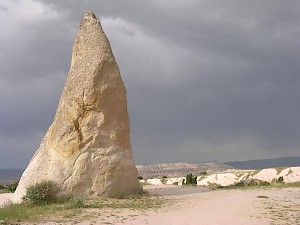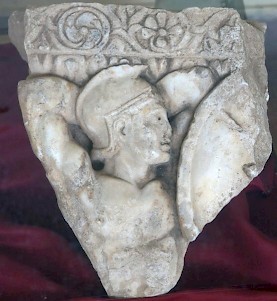Cappadocia (2)
Cappadocia: ancient name for the country between the rivers Halys and Euphrates, today central Turkey.
Hellenistic Age

After the death of Alexander, on 11 June 323 in Babylon (text), his commanders elected Perdiccas as regent of the great conqueror's brother Philip Arridaeus and his still unborn son Alexander IV. A Greek officer named Eumenes was made satrap of Cappadocia (text). He had to fight against the Ariarathes who had fought for the last Persian king, Darius III Codomannus, at Gaugamela, and had continued to war against the local Macedonian commander Antigonus the One-Eyed. However, when Perdiccas invaded Cappadocia, Antigonus did not appear, which was one of the reasons why the successors of Alexander (the Diadochi) started to quarrel: the First Diadoch War. However, for the time being, Perdiccas was successful and Ariarathes was captured and killed.
The main consequence of the First Diadoch War was the end of Perdiccas, his attempt to keep the empire unified, and the end of Eumenes' main supporter. At a conference in Triparadisus, a general named Antipater reorganized the Macedonian Empire (text), and appointed Nicanor as satrap of Cappadocia. With Antigonus, he had to expel Eumenes. This was the beginning of the Second Diadoch War (318-315), which was won by Antigonus, and when Nicanor died during the Babylonian War, the old one-eyed general added Cappadocia to his territories. However, he was defeated decisively in the battle of Ipsus (301), and the southern fringe of Cappadocia was added to the realms of Seleucus I Nicator (the Seleucid Empire).
A nephew of Ariarathes, Ariarathes II, seized the central and northern part of Cappadocia, and was accepted by Seleucus as a semi-dependent ruler. (Northern Cappadocia became the new kingdom Pontus.) When Seleucus had died and his succession was contested by Ptolemy II Philadelphus, Ariarathes II and Orontes III of Armenia defeated the Seleucid army (c.280 BCE), which meant the beginning of independence. The lawful king Antiochus I Soter acquiesced in this situation because he was involved in the First Syrian War against the Ptolemaic Empire.
Ariarathes was succeeded by his son Ariaramnes, whose son Ariarathes III was the first to accept the royal title. Nearly all Cappadocian kings called themselves Ariarathes, just like Egyptian kings of that age all called themselves Ptolemy and all Parthian rulers were known as Arsaces. The third Ariarathes was able to normalize relations with the powerful Seleucid neighbors and married Stratonice III, the daughter of Antiochus II Theos. This diplomatic alliance was further strengthened when their son, Ariarathes IV Eusebes, married Antiochis, daughter of his Seleucid cousin Antiochus III the Great.
However, the decline of Seleucid power forced the Cappadocian kings, who by now had come to claim descent from the Achaemenid prince Pharnaces, to look for other allies. During the Second Macedonian War (200-196), the Roman commander Titus Quinctius Flamininus had defeated the Macedonian king Philip V, and because the legions had been recalled, a power vacuum had been created. Antiochus III was more or less forced to intervene in the chaos Rome had created, which offered the Romans the opportunity to intervene again. In the Syrian War (192-188), the legions swept away the Seleucid armies (battle of Magnesia, 190). Immediately, Ariathes IV switched sides. His daughter Stratonice IV married king Eumenes II of Pergamon, a Roman ally. Rome accepted this diplomatic gambit and supported Cappadocia when war broke out with king Pharnaces I of Pontus (182-179). Some ten years later, Rome requested Cappadocian support in the Third Macedonian War.

In 163, Ariarathes V Philopator succeeded his father. He intervened in a crisis in Sophene (along the Upper Tigris), where he put Mithrobuzanes on the throne, a puppet king. The Seleucid ruler Demetrius I Soter now proposed to renew marriage ties, which Ariarathes refused. Demetrius now supported an insurrection by Ariarathes' brother Orophernes. The Roman Senate ordered the two dynasts to split the kingdom, but in 158, Ariarathes V was restored by king Attalus II Philadelphus of Pergamon, second husband of Ariathes' sister Stratonice.
In 152, Ariarathes saw an opportunity to avenge himself on Demetrius. He joined a Rome-supported anti-Seleucid coalition; the other members were Attalus II Philadelphus of Pergamon and Ptolemy VI Philometor of Egypt. Together, they put the Seleucid pretender Alexander I Balas on the throne.
Some twenty years later, king Attalus III Philometor, the son of Stratonice, died, leaving the Pergamene kingdom to Rome. Because a native leader, Aristonicus, tried to regain independence, war broke out, and Ariarathes V supported Rome again. In return, it received Lycaonia. When he was killed in action in 131/130 and was succeeded by Ariarathes VI Epiphanes, independent Cappadocia was larger than it had ever been. The Roman alliance had been a wise policy.
However, Rome was not yet able to protect its ally against the new regional power: Pontus, which had survived the war of 182-179 and was rapidly increasing its strength. Ariarathes VI tried to appease his northern neighbor and married Laodice, a sister of its young king Mithridates, who became the real power in Cappadocia, saw to the assassination of her husband, and in 103 allied herself to king Nicomedes III Euergetes of Bithynia against her son Ariarathes VII Philometor. Two years later, Mithridates of Pontus intervened, expelled his sister and Nicomedes, restored Ariarathes VII, but on second thoughts decided to put his own son on the throne, Ariathes Eusebes.
This was only the beginning of a series of civil wars, in which the last member of the dynasty, Ariarathes VIII, was soon killed. The Cappadocian nobility elected a new king, Ariobarzanes I Philoromaeus, who was recognized by the Roman Senate, but found it difficult to rule. In 95/94, he was expelled from his land by king Tigranes the Great of Armenia, returned, and was expelled again in 90 and 89 by Mithridates of Pontus, but returned and expelled Ariarathes Eusebes in c.88. During the Third Mithradatic War (73-63), Ariobarzanes had to leave his country again, but the Roman general Pompey the Great, who utterly defeated Pontus, put the Cappadocian leader back on the throne, added Sophene and Gordyene (east of the Tigris) to his realm, and took away Lycaonia.

Ariobarzanes abdicated in 62 and was succeeded by his son Ariobarzanes II Philopator, who was killed in 51 and succeeded by Ariobarzanes III Eusebes, who was immediately faced with the greatest challenged a loyal ally of Rome could have to face: civil war in Rome. Be choose to support Pompey, but the war was won by his enemy Julius Caesar (48, battle of Pharsalus). Ariobarzanes, however, managed to switch sides and when a son of Mithridates VI, Pharnaces, tried to restore the power of Pontus, Julius Caesar came to the help of Cappadocia and defeated the rebel at Zela (47: "I came, saw, conquered"). Even better, parts of western Armenia were added to Cappadocia.
However, a new Roman civil war broke out after the assassination of Caesar in Rome. The assassins occupied the eastern provinces, and Gaius Cassius Longinus put an end to the rule of Ariobarzanes III, who was replaced by his brother Ariarathes IX Philadelphus. After the civil war had been won by the leaders of the Caesarian faction (Mark Antony and Octavian; battle of Pilippi, 42), the Romans decided to recognize the high priest of Comana as new king, Archelaus. Cappadocia was expanded even more when Octavian had become sole ruler (emperor Augustus), and added parts of Rough Cilicia. In 17 CE, the Roman emperor Tiberius added Cappadocia as province to the empire. Its first governor was Quintus Veranius, an adjutant of the Roman prince Germanicus.
| Ariarathes I | c.333-322/321 |
| Ariarathes II | 301-c.280 |
| Ariamnes | c.280-230 |
| Ariarathes III | c.255-220 |
| Ariarathes IV Eusebes | 220-c.163 |
| Ariarathes V Eusebes Philopator | c.163-131/130 |
| Orophernes II (rebel) | c.158 |
| Ariarathes VI Epiphanes Philopator | 131/130-116 or 111 |
| Ariarathes VII Philometor | 116 or 111-101 |
| Ariarathes Eusebes (usurper) | 101-88 |
| Ariarathes IX | 101-c.96 |
| Ariarathes VIII | 101-c.96 |
| Ariobarzanes I Philoromaeus | c.96-c.62 |
| Ariobarzanes II Philopator | c.62-52/51 |
| Ariobarzanes III Eusebes | 52/51-42 |
| Ariarathes X Eusebes Philadelphos | 42-41 |
| Archelaus | 41 BCE -17 CE |